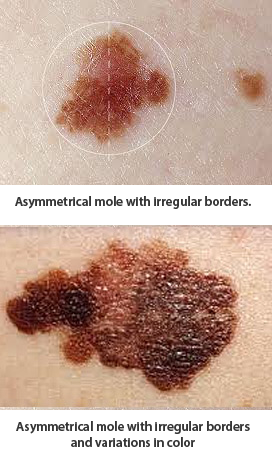Malignant Melanoma – Information
Malignant melanoma is the third most common form of skin cancer and is increasing at nearly an epidemic rate. Melanoma is an aggressive form of skin cancer that often appears as an irregularly-shaped, irregularly pigmented, multi-colored, asymmetric pigmented flat or raised spot that may appear anywhere on the body. As this tumor does metastasize (spread to the lymph nodes and internal organs), early detection and thus early treatment is critical.

Nearly all melanomas are treated surgically, by cutting the tumor out. Depending upon the thickness (how deep the tumor goes into the skin), staging procedures may be recommended and may include: chest x-ray, CT-scan, PET scan, sentinel lymph node biopsy, and blood tests.
Treatment of metastatic disease (that which has already spread to the lymph nodes or other organs) is difficult and is often managed by a team of doctors, including surgical and medical oncologists. When possible, metastatic tumors and lymph nodes are removed surgically. Other treatments of metastatic melanoma may include radiation therapy, chemotherapy, or interferon.
It is recommended that people, especially persons with moles, perform monthly self skin examinations. The following are signs of melanoma:
A: Asymmetry = if one draws a line through the center of the mole, one side would not be the same as the other. Asymmetrical mole with irregular borders.
B: Irregular Border = the border of the mole is irregularly shaped
C: Variations in Color = more than one color or shade. Asymmetrical mole with irregular borders and variations in color.
D: Diameter larger than 4mm = Most persons have moles with one of the above signs (especially size), but two or more certainly warrants evaluation by a board-certified Dermatologist. Additionally, change in a mole would also warrant evaluation, although normal moles can change with time and is normal.
